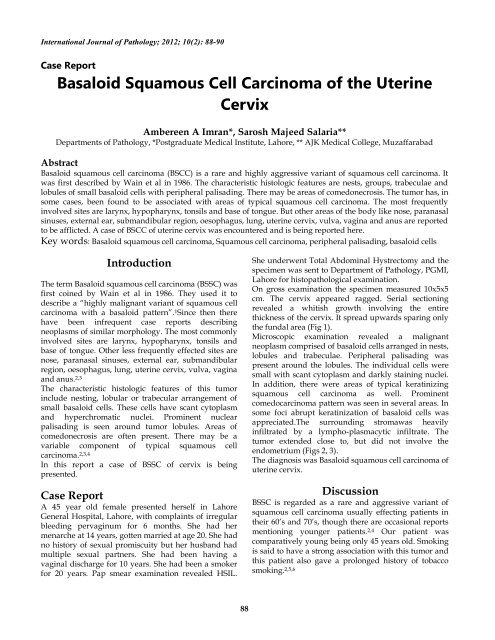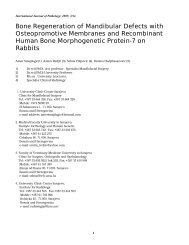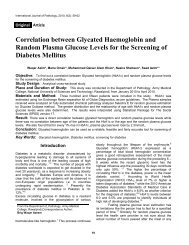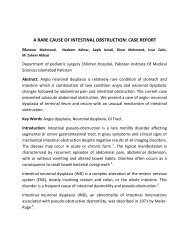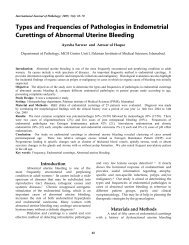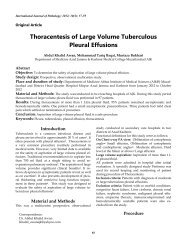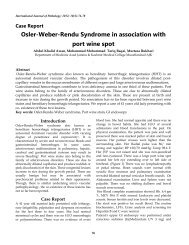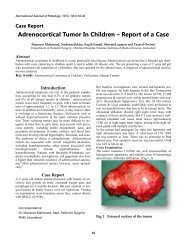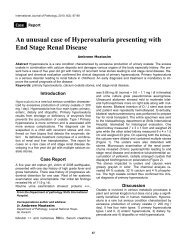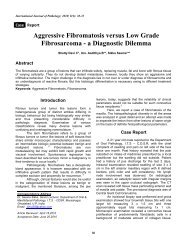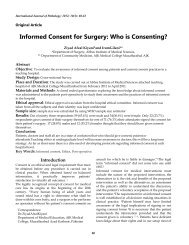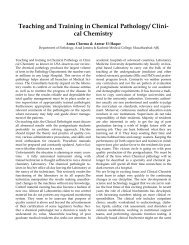Basaloid Squamous Cell Carcinoma of the Uterine Cervix
Basaloid Squamous Cell Carcinoma of the Uterine Cervix
Basaloid Squamous Cell Carcinoma of the Uterine Cervix
Create successful ePaper yourself
Turn your PDF publications into a flip-book with our unique Google optimized e-Paper software.
International Journal <strong>of</strong> Pathology; 2012; 10(2): 88-90<br />
Case Report<br />
<strong>Basaloid</strong> <strong>Squamous</strong> <strong>Cell</strong> <strong>Carcinoma</strong> <strong>of</strong> <strong>the</strong> <strong>Uterine</strong><br />
<strong>Cervix</strong><br />
Ambereen A Imran*, Sarosh Majeed Salaria**<br />
Departments <strong>of</strong> Pathology, *Postgraduate Medical Institute, Lahore, ** AJK Medical College, Muzaffarabad<br />
Abstract<br />
<strong>Basaloid</strong> squamous cell carcinoma (BSCC) is a rare and highly aggressive variant <strong>of</strong> squamous cell carcinoma. It<br />
was first described by Wain et al in 1986. The characteristic histologic features are nests, groups, trabeculae and<br />
lobules <strong>of</strong> small basaloid cells with peripheral palisading. There may be areas <strong>of</strong> comedonecrosis. The tumor has, in<br />
some cases, been found to be associated with areas <strong>of</strong> typical squamous cell carcinoma. The most frequently<br />
involved sites are larynx, hypopharynx, tonsils and base <strong>of</strong> tongue. But o<strong>the</strong>r areas <strong>of</strong> <strong>the</strong> body like nose, paranasal<br />
sinuses, external ear, submandibular region, oesophagus, lung, uterine cervix, vulva, vagina and anus are reported<br />
to be afflicted. A case <strong>of</strong> BSCC <strong>of</strong> uterine cervix was encountered and is being reported here.<br />
Key words: <strong>Basaloid</strong> squamous cell carcinoma, <strong>Squamous</strong> cell carcinoma, peripheral palisading, basaloid cells<br />
Introduction<br />
The term <strong>Basaloid</strong> squamous cell carcinoma (BSSC) was<br />
first coined by Wain et al in 1986. They used it to<br />
describe a “highly malignant variant <strong>of</strong> squamous cell<br />
carcinoma with a basaloid pattern”. 1 Since <strong>the</strong>n <strong>the</strong>re<br />
have been infrequent case reports describing<br />
neoplasms <strong>of</strong> similar morphology. The most commonly<br />
involved sites are larynx, hypopharynx, tonsils and<br />
base <strong>of</strong> tongue. O<strong>the</strong>r less frequently effected sites are<br />
nose, paranasal sinuses, external ear, submandibular<br />
region, oesophagus, lung, uterine cervix, vulva, vagina<br />
and anus. 2,3<br />
The characteristic histologic features <strong>of</strong> this tumor<br />
include nesting, lobular or trabecular arrangement <strong>of</strong><br />
small basaloid cells. These cells have scant cytoplasm<br />
and hyperchromatic nuclei. Prominent nuclear<br />
palisading is seen around tumor lobules. Areas <strong>of</strong><br />
comedonecrosis are <strong>of</strong>ten present. There may be a<br />
variable component <strong>of</strong> typical squamous cell<br />
carcinoma. 2,3,4<br />
In this report a case <strong>of</strong> BSSC <strong>of</strong> cervix is being<br />
presented.<br />
Case Report<br />
A 45 year old female presented herself in Lahore<br />
General Hospital, Lahore, with complaints <strong>of</strong> irregular<br />
bleeding pervaginum for 6 months. She had her<br />
menarche at 14 years, gotten married at age 20. She had<br />
no history <strong>of</strong> sexual promiscuity but her husband had<br />
multiple sexual partners. She had been having a<br />
vaginal discharge for 10 years. She had been a smoker<br />
for 20 years. Pap smear examination revealed HSIL.<br />
She underwent Total Abdominal Hystrectomy and <strong>the</strong><br />
specimen was sent to Department <strong>of</strong> Pathology, PGMI,<br />
Lahore for histopathological examination.<br />
On gross examination <strong>the</strong> specimen measured 10x5x5<br />
cm. The cervix appeared ragged. Serial sectioning<br />
revealed a whitish growth involving <strong>the</strong> entire<br />
thickness <strong>of</strong> <strong>the</strong> cervix. It spread upwards sparing only<br />
<strong>the</strong> fundal area (Fig 1).<br />
Microscopic examination revealed a malignant<br />
neoplasm comprised <strong>of</strong> basaloid cells arranged in nests,<br />
lobules and trabeculae. Peripheral palisading was<br />
present around <strong>the</strong> lobules. The individual cells were<br />
small with scant cytoplasm and darkly staining nuclei.<br />
In addition, <strong>the</strong>re were areas <strong>of</strong> typical keratinizing<br />
squamous cell carcinoma as well. Prominent<br />
comedocarcinoma pattern was seen in several areas. In<br />
some foci abrupt keratinization <strong>of</strong> basaloid cells was<br />
appreciated.The surrounding stromawas heavily<br />
infiltrated by a lympho-plasmacytic infiltrate. The<br />
tumor extended close to, but did not involve <strong>the</strong><br />
endometrium (Figs 2, 3).<br />
The diagnosis was <strong>Basaloid</strong> squamous cell carcinoma <strong>of</strong><br />
uterine cervix.<br />
Discussion<br />
BSSC is regarded as a rare and aggressive variant <strong>of</strong><br />
squamous cell carcinoma usually effecting patients in<br />
<strong>the</strong>ir 60’s and 70’s, though <strong>the</strong>re are occasional reports<br />
mentioning younger patients. 2,4 Our patient was<br />
comparatively young being only 45 years old. Smoking<br />
is said to have a strong association with this tumor and<br />
this patient also gave a prolonged history <strong>of</strong> tobacco<br />
smoking. 2,5,6<br />
88
International Journal <strong>of</strong> Pathology; 2012; 10(2): 88-90<br />
Human papilloma virus (type 16, 18), a sexually<br />
transmitted agent, has long been associated with<br />
typical squamous cell carcinoma as well its basaloid<br />
and warty variants. 7,8 Though our patient kept herself<br />
confined to one partner, her husband had multiple<br />
partners. This scenario is reported to be one <strong>of</strong> <strong>the</strong><br />
established risk factors involved in transmission <strong>of</strong><br />
HPV. 9<br />
Microscopic picture was characteristic. The small<br />
basaloid cells arranged in nests, lobules and trabeculae<br />
are <strong>the</strong> hallmark <strong>of</strong> <strong>the</strong> tumour (Fig 2). Peripheral<br />
palisading around individual lobules was prominent in<br />
most areas, as described by numerous authors. 2,4,5<br />
This case was associated with high grade dysplasia <strong>of</strong><br />
overlying epi<strong>the</strong>lium, which was reported in pas smear<br />
as HSIL. This finding has also been reported before. 2,5<br />
The case under consideration had a prominent<br />
component <strong>of</strong> well differentiated squamous cell<br />
carcinoma as well. This association is variable; some<br />
o<strong>the</strong>r reports also mention such areas while o<strong>the</strong>rs do<br />
not. 6,10 The pattern <strong>of</strong> comedonecrosis is a more<br />
frequent companion <strong>of</strong> <strong>the</strong> lesion, to <strong>the</strong> extent that<br />
some authors consider it to be “one <strong>of</strong> <strong>the</strong> main<br />
characteristics <strong>of</strong> <strong>the</strong> lesion”. 4,5 The abrupt<br />
keratinization seen within islands <strong>of</strong> basaloid cells<br />
(Fig3) has also been noted previously. 4,11<br />
The differential diagnosis should include squamous<br />
cell carcinoma, basal cell carcinoma, adenoid cystic<br />
carcinoma, adenosquamous carcinoma, spindle cell<br />
squamous carcinoma, mucoepidermoid carcinoma,<br />
adenoid squamous carcinoma, small cell<br />
neuroendocrine carcinoma, and basosquamous cell<br />
carcinoma. 3,4,12<br />
The characteristic morphological features usually make<br />
this differentiation easy but if in doubt, multiple<br />
sections may be submitted to ensure accurate<br />
categorization. In certain cases, immunohistochemistry<br />
may come in handy to unveil <strong>the</strong> true nature <strong>of</strong> <strong>the</strong><br />
neoplasm. 4,8 This differentiation is relevant because<br />
BSCC differs in biological behavior, prognosis and<br />
<strong>the</strong>rapeutic strategy from <strong>the</strong> o<strong>the</strong>r listed entities. 3,12<br />
Figure 1: Cut surface <strong>of</strong> <strong>the</strong> specimen at level <strong>of</strong><br />
maximum spread to show extensive myometrial<br />
involvement by <strong>the</strong> tumour.<br />
Figure 2: Small groups <strong>of</strong> basaloid cells in a<br />
trabecular pattern are seen extending close to but not<br />
involving <strong>the</strong> endometrial cavity. (H & E, x 100)<br />
Conclusion<br />
BSCC, an aggressive and fortunately rare, variant <strong>of</strong><br />
squamous cell carcinoma is being reported in <strong>the</strong><br />
uterine cervix. Although mixed with areas <strong>of</strong> typical<br />
squamous cell carcinoma, <strong>the</strong> characteristic histologic<br />
features usually make it easy for <strong>the</strong> histopathologists<br />
to spot <strong>the</strong> tumor. It should be reported in clear and<br />
unambiguous terms to ensure management <strong>of</strong> <strong>the</strong><br />
patient along appropriate lines.<br />
Figure 3: A small nest <strong>of</strong> basaloid cells showing<br />
central keratinization. (H & E, x 400)<br />
Acknowledgement: The cooperation <strong>of</strong> Dr. QuratulAin<br />
in providing clinical data <strong>of</strong> <strong>the</strong> patient is highly<br />
appreciated.<br />
89
International Journal <strong>of</strong> Pathology; 2012; 10(2): 88-90<br />
References<br />
1. Wain SL, Kier R, Vollmer RT, Bossen EH. <strong>Basaloid</strong><br />
squamous cell carcinoma <strong>of</strong> <strong>the</strong> tongue, hypopharynx<br />
and larynx. Report <strong>of</strong> 10 cases. Hum Pathol1986;<br />
17:1158–66.<br />
2. Vasudev P, Boutross-Tadross O, Radhi J. <strong>Basaloid</strong><br />
squamous cell carcinoma: two case reports. Cases<br />
Journal 2009; 2: 9351.<br />
3. Soprani F, Armaroli V, Stefanelli A, Emiliani<br />
E, Padovani D, CasolinoD.<strong>Basaloid</strong> squamous cell<br />
carcinoma <strong>of</strong> <strong>the</strong> larynx: report <strong>of</strong> a early laryngeal<br />
cancer. ActaOtorhinolaryngolItal 2011; 31:181-5.<br />
4. Wieneke JA, Thompson LD, Wenig BM. <strong>Basaloid</strong><br />
squamous cell<br />
carcinoma <strong>of</strong> <strong>the</strong> sinonasal tract. Cancer 1999; 15:841-<br />
854.<br />
5. Morles-Puebla JM, Toro-Rojas M, Gerons RSS,<br />
Fernandez JF, Villarejo PL. <strong>Basaloid</strong> squamous cell<br />
carcinoma: Report <strong>of</strong> five cases. <strong>Basaloid</strong> squamous cell<br />
carcinoma: Report <strong>of</strong> five cases. Med Oral Patol Oral Cir<br />
Bucal 2010; 15: 451-5.<br />
6. Wang LC, Wang L, Kwauk S, Woo JA, Wu LQ, Zhu H,<br />
Zhan LZ, Sun NL, Zhang L. Analysis on <strong>the</strong> clinical<br />
features <strong>of</strong> 22 basaloid squamous cell carcinoma <strong>of</strong> <strong>the</strong><br />
lung. J Cardiothoracic Surg 2011; 6:10.<br />
7. Velazquez EF, Cubilla AL. Penile squamous cell<br />
carcinoma: anatomic, pathologic and viral studies in<br />
Paraguay (1993-2007). Anal Quant CytolHistol 2007;<br />
29:185-98.<br />
8. Cubilla AL, Reuter VE, Gregoire L, Ayala G, Ocampos<br />
S, Lancaster WD, Fair W. <strong>Basaloid</strong> squamous cell<br />
carcinoma: a distinctive human papilloma virus-related<br />
penile neoplasm: a report <strong>of</strong> 20 cases. Am J<br />
SurgPathol 1998 ; 22:755-61.<br />
9. Kahesa C, Mwaiselage J, Wabinga HR, Ngoma T,<br />
Kalyango JN, Karamagi CAS. Association between<br />
invasive cancer <strong>of</strong> <strong>the</strong> cervix and HIV-1 infection in<br />
Tanzania: <strong>the</strong> need for dual screening. BMC Public<br />
Health 2008; 8:262.<br />
10. Raslan WF, Barnes L, Kraus JR, Contis L, Killeen R,<br />
Kapadia SB. <strong>Basaloid</strong> squamous cell carcinoma <strong>of</strong> <strong>the</strong><br />
head and neck: a clinicopathologic and flow cytometric<br />
study <strong>of</strong> 10 new cases with review <strong>of</strong> <strong>the</strong> English<br />
literature. Am J Otolaryngol1994; 15:204–<br />
11.<br />
11. Satish BNVS, Kumar P. <strong>Basaloid</strong> <strong>Squamous</strong> <strong>Cell</strong><br />
<strong>Carcinoma</strong> – A Case Report. Int J Dental Clinics 2010;<br />
2:31-33.<br />
12. S. I. Hussain, A. S. Hussainy. Baso-<strong>Squamous</strong> <strong>Cell</strong><br />
<strong>Carcinoma</strong> - a Case Report. J Pak Med Assoc 2004; 54:<br />
30-32.<br />
90


